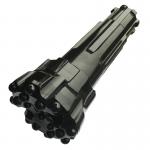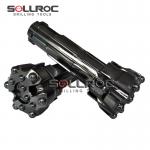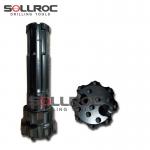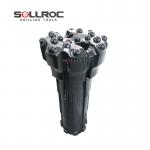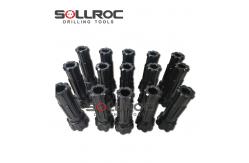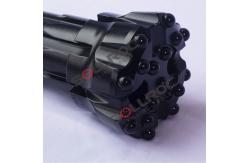5.5'' RC Bit With Drop Center Face And Carburized Treatment SRC547
For Sampling
Product Introduce:
Reverse circulation (RC) drilling uses a bit attached to a
down-hole hammer to produce a hole. Unlike diamond drilling, RC
drilling produces samples of rock cuttings rather than a sample of
rock core. The down-hole hammer is powered by compressed air, which
also acts as the medium bringing the drill cuttings up to surface.
It is mainly used in deep hole exploration and mining ore grade
control.
Specification:
SRC547 series drill bit specification
| Drill bit shank | Bit diameter
(mm) | Guage | Front | Center | Recommend shroud | weight (kg) |
| buttons | buttons | buttons |
| SRC547 | 136 | 8×φ16 | 6×φ16 | 3×φ14 | 134 | 14.2 |
| 140 | 8×φ16 | 6×φ16 | 3×φ14 | 138 | 14.5 |
| 143 | 8×φ16 | 6×φ16 | 3×φ14 | 141 | 14.7 |
| 146 | 8×φ16 | 6×φ16 | 3×φ14 | 144 | 15 |
SRC547 Hammer specification
Shank
| Length | Weight | External diameter | Bit hole range | Connect thread | Working pressure | Impact rate at 2.4Mpa | Recommend rotation speed |
|
SRC547
| 1270mm | 74kgs | 124.5mm | 130-146mm | 4.5" Remet
/Metzke | 1.5-3.5Mpa | 35Hz | 25-40rpm |
Adavantages:
1.Spare parts are made of quality raw material with carburized
treatment offer good wear resistance. The hammer achieve excellent
wear resistance and high penetration rate
2.Various selection for bit head shape, button shape and button
configuration. It can completely satisfy the customization
requirement and have adaptability to varies of rock conditions.
3.The bit is interchangeable with well-known brand shank. The
interchangeable shank design helps customers to optimized
inventory.
Basics of Reverse Circulation Drilling:
(1) RC drilling uses rods with inner and outer tubes, the drill
cuttings are returned to surface inside the rods. The drilling
mechanism is a pneumatic reciprocating piston known as a hammer
driving a tungsten-steel drill bit.
(2) RC drilling utilizes much larger rigs and machinery and depths
of up to 500 meters are routinely achieved. RC drilling ideally
produces dry rock chips, as large air compressors dry the rock out
ahead of the advancing drill bit.
(3) RC drilling is slower and costlier but achieves better
penetration than RAB or air core drilling; it is cheaper than
diamond coring and is thus preferred for most mineral exploration
work.
(4) Reverse circulation is achieved by blowing air down the annulus
of the rod, the differential pressure creating air lift of the
water and cuttings up the inner tube which is inside each rod. It
reaches the deflector box at the top of the drill string then moves
through a sample hose which is attached to the top of the cyclone.
The drill cuttings travel around the inside of the cyclone until
they fall through an opening at the bottom and are collected in a
sample bag. For any drill hole there will be a large number of
sample bags, each one marked to record the location and drilling
depth that the sample was obtained.
The collected series of sample bag cuttings are later taken for
analysis to determine the mineral composition of the drill hole.
The analysis results of each individual bag represents the mineral
composition at a particular sample point in the drill hole.
Geologists can then survey the drilled ground analysis and make
decisions about the value of the overall mineral deposit.
Photo:
About us:
SOLLROC Reverse Circulation drilling (RC) ,from size 3’’ to 5.5’’,
is a technique of drilling that uses dual wall drill rods that
consist of an outer drill rod with an inner tube. By using
compressed air to extract rock fragments sample,the samples travel
through rods to a sample splitter at surface, avoiding all contact
between the samples and the borehole wall that allows samples to be
retrieved with minimal contamination,which is mainly used in deep
hole exploration and mining grade control.
Delivery Way:
By Air, By express or By Sea
Package :
Ply-wooden cases + pallet
